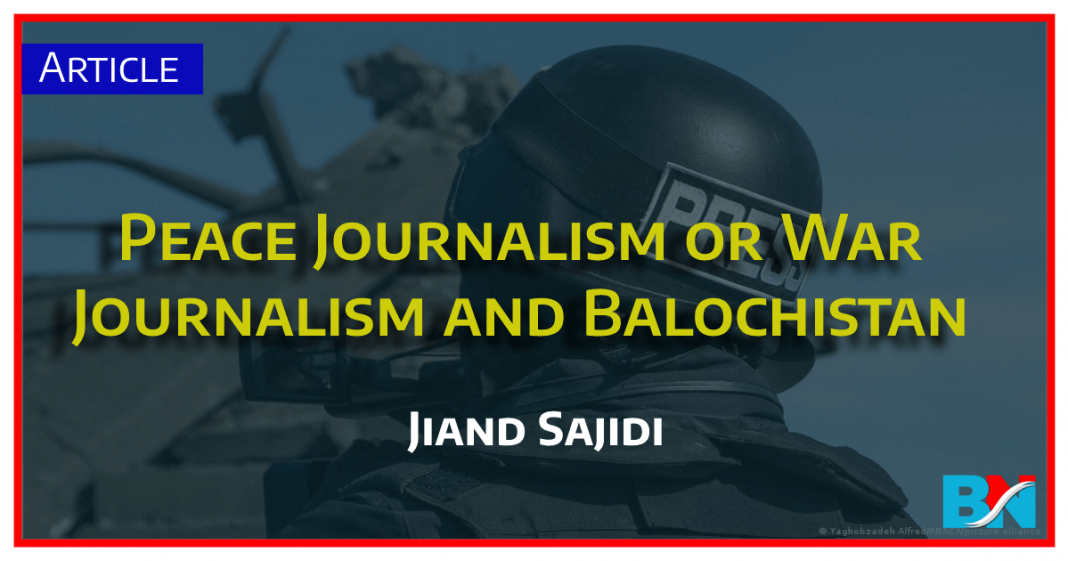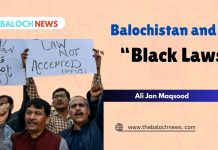Translation by Abdullah Baloch
Jack Lynch is the teacher of Communication Department at Sydney University of Australia. He got fame for his research work on Peace Journalism. He cribbed three kinds of violence and advised that the media should speak on the three kinds of violence during a war or dispute. According to him, if media does not talk about the three kinds of violence in its reports, then it will further escalate the war which comes under the domain of War Journalism. He further writes that people are often aware about only one type of violence which they named as direct violence. As per him, direct violence is committed at that time when a powerful group or state directly uses military power to inflict violence on a weaker or minority linguistic or religious group, for example, beating people of occupied linguistic group, extrajudicial abductions and killings or doing bombardment on the regions of minority-nations.
Quoting Jack Lynch, people are often wholly unknown of the two other kinds of violence, although these two kinds of violence have deep relation with direct violence. He writes that in a multinational state, the majority-nation or their state, before the use of direct violence, uses structural violence on a minority-nation. Structural violence means that a minority-nation is kept afar from important administrative positions under a policy. The purpose of this is to make their economic, social and political power fragile. The representation of a minority-nation is kept very low in the state institutions such as National Assembly, Police, Military, Judiciary and so forth. When some conscious leaders, feeling the prejudicial behaviors, point out the injustices, then the upper (ruling) community brings into their use the cultural violence with them.
Cultural violence is, in fact, a kind of racism, by using which the minority community is attempted to have the belief that the state is not responsible for their backwardness rather they themselves are. The main reason of this is the cultural traditions which are based on conservatism. When the people of minority community demonstrate mental maturity and do not come under the clutches of state propaganda and continue the struggle of their due rights, then the powerful group, by portraying its fascist thoughts, inflicts violence directly through its police or military power. If we study the history of colonisation, then multiple examples of Structural and Cultural violence can be traced. In India, the British coloniser appointed people of British and European origins on higher positions and local people were kept away from significant positions. It falls under the domain of structural violence. The British imperialists brought before them the excuses that the Indian people were not able for these because of their race that they should be hired on administrative positions. This is an example of cultural violence. When the local Indians raised their voices against these exploitations, then they had to confront the direct violence of the British imperialism.
Baloch have had to face the three kinds of violence. The attitude of the center towards the Baloch has been the same for the last 74 years and Baloch have been facing the three kinds of violence. First of all, they faced Structural violence and their representation in the important positions of state institutions was equal to nothing. Balochistan has merely 17 seats in the Federal Government today, while 170 seats are required for forming the government, which means that here the representatives can never make government of their own at federal level and neither can they legislate regarding Balochistan. Center is a far cry, Baloch have been even victimised of Structural violence in their own province. Right after the annexation, the center has populated settlers from other provinces here who, sitting in 20 streets of Quetta, are running the system of the whole province, while their knowledge regarding Balochistan was as low that they did not even know the names of four districts of Balochistan. Till now, settlers from the other provinces are appointed on the important positions of the province and their attitude towards local people is similar to that of a colonial settler.
Whenever the Baloch leaders condemned the discriminatory behavior or structural violence of the center, then the center used cultural violence with the Baloch by utilising its “patriotic media”. As per the center, the given realm of Baloch is because of their tribal system and they (Baloch) endorse everything of their chiefs (Sardar) like idol worshippers and elect them over and again and send them to the assemblies. The center thinks, chiefs are also ineligible like the other tribal Baloch and they have no capability to run the affairs of a provincial government. Center, mainstream media and the nominal journalists of state-level are not heedless of what the ground realities of Balochistan are and how much laceration Baloch suffer from this cultural violence. When Baloch struggled against these two kinds of violence (Cultural and Structural violence), then the center has directly used violence on them. Ayub Khan in 1958, Zulfiqar Ali Bhutto in 1972 and Pervez Musharraf in 2006 used excessive powers in Balochistan. A few days ago, some videos passed through my sight in which Sindh police was inflicting undue violence on peaceful Baloch protesters.
According to Jack Lynch, media can play a key role in the solution of any war and dispute. He says, if media gives coverage to direct violence of some representatives of majority or minority groups, then dispute further increases from this. In his opinion, the media should also mention the structural and cultural violence being exacted on the minority-nation. By this, public opinion will be influenced and in the fair of public opinion, the elite of upper class will not directly impose atrocities or violence on the minority-nation and the problem can go towards a solution. But here Ganga (river) is flowing reverse. Here, the patriotic media gives coverage to some acts of Baloch militant organisations by exaggerating them, while events like Karachi incident, where state power was used, is blacked out. The national media never held any program on structural violence and has played a key role in the infliction of cultural violence on Baloch.
By this, it is felt that instead of Peace Journalism, media is promoting War Journalism. Montserrat Guibernau, a professor at University of London School Of Economics in British, writes that whenever illegal state power is used on any minority-nation, then the national consciousness of the group further increases. By the act of the center and the media, it seems that dispute of Balochistan is not going to be solved in near future, rather due to wrong policies, it will intensify more and incidents like Karachi will further increase national consciousness of Baloch.










